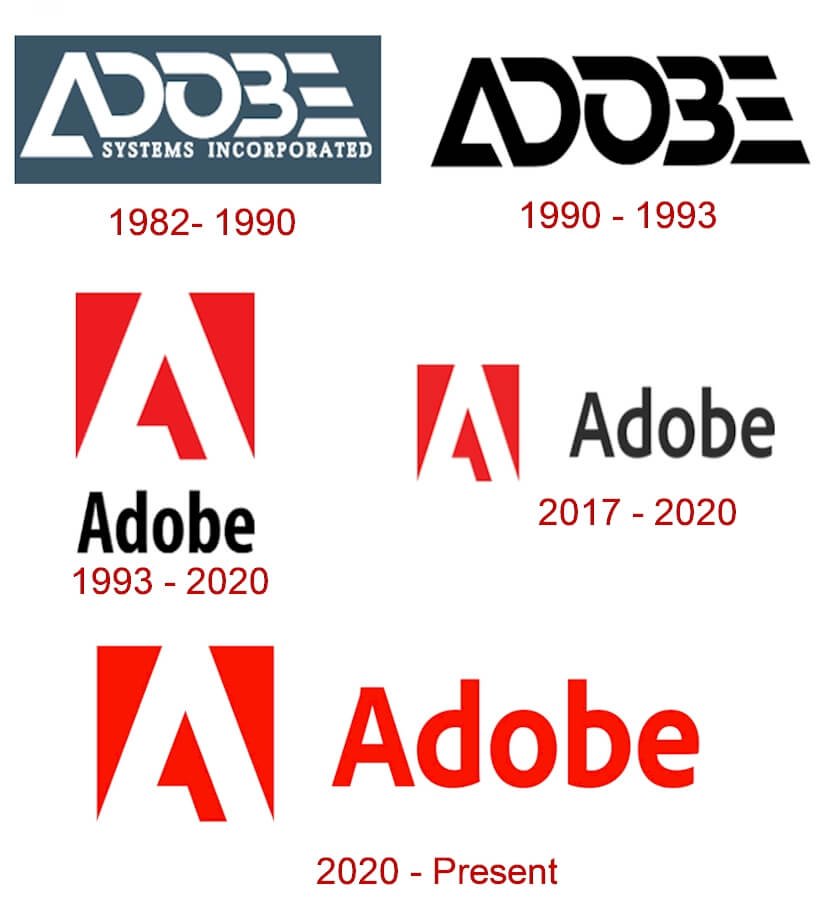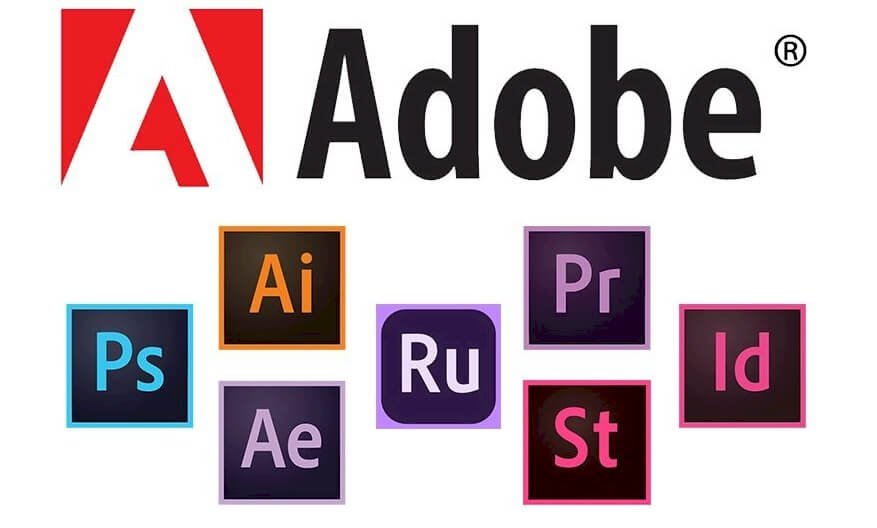Let’s look at the Adobe logo and some history behind the business.
Can you imagine the world without copyrighters, marketers, and graphic artists? And how would companies approach branding without the required tools?
Professionals have the tools to make the world of branding an attractive one. And about 90% of these professionals use adobe products for their creative designs.
Adobe rules the creative industry. Since it came into existence in 1982, it has launched many innovative products. These products have become the backbone of marketers, graphic designers, and copywriters. It’s the global leader in digital media and marketing solutions.
 Adobe has a custom stylized wordmark logotype; it has a red, white, and black color scheme. It has minimal design elements and easy on the eye. Adobe’s logo greets millions of people every day via major promotional networks.
Adobe has a custom stylized wordmark logotype; it has a red, white, and black color scheme. It has minimal design elements and easy on the eye. Adobe’s logo greets millions of people every day via major promotional networks.
You can find the logo on social media, digital platforms, and on television. Others are t-shirts, catalogs, billboards, etc. The trademark and its quality products have earned the brand a market cap of $241.27 billion.
The Evolution of the Adobe Logo
Adobe’s logo has evolved over the years, and it’s not a unique case at all. Its current trademark is unlike the original one used in 1982. It’s different and exceptional. Most iconic logos change to meet the changing needs of their organizations.
Such was the case with Adobe, Inc. For the past 38 years, it has redesigned its visual symbol four times. The changes have affected their color palette, shape, and typeface. It has been a splendid exercise for the brand. Now, let’s look at the various updates below:
1982 to 1990—The Original Adobe Logo
The first logo came into existence in 1982. Marva Warnock, the wife of co-founder John Warnock, designed it. The emblem comprises two design elements–a rectangle and typeface. She placed the bold white stylized wordmark inside a dark gray rounded rectangle.
The custom font was all caps, legible, and attractive. The first letter—A, looks like an opened triangle. And the last letter—E, comprises three horizontal stripes.

1990 to 1993—First Adobe Logo Update
After about eight years, the first update took effect. In 1990, the logo became more simplified. Its rounded background went off, and the brand’s name took on black color. The stylized name remained, but the designer erased the rest of the inscriptions. The logo looked more modern, minimalist, and attractive.
1993 to 2017—Second Adobe Logo Update
In 1993, the company had its second update. The board took that decision to reflect the brand’s range of products. The logo took on a new color palette of red, white, and black. The designer placed the original stylized letter—A inside a red square background. Under it was the brand’s name in black color.
2017 to 2020—Third Adobe Logo Update
In 2017, the third redesign took place. Its white letter—A and red square background remained intact. But the wordmark moved to the right. The lettering took on a relaxed tone. And the letters—d and b looked rounded and mirrored to each other. Also, the color of the wordmark remained unchanged.
2020 to Present—Fourth Adobe Logo Update
Adobe’s current logo has a minor change. Its red and white colors are brighter than the previous one. The wordmark on the right is no longer black but bright red. And the company has maintained its core values.
Why the Adobe Logo Works?
We can place Adobe’s logo among the iconic trademarks in the world. It has everything that a good emblem should have. Thus, fewer graphic elements, which gives it a modest outlook. The colors, font, and shape complement each other to convey a coherent message.
Loyalty is a priceless value that takes time for brands to earn. Though the trademark has undergone a few changes, its core values remain intact. The consistency of the logo design over time has earned the loyalty of customers.
The logo, with its minimalist attributes, is recognizable, memorable, and timeless. It’s also scalable on all promotional channels. We can also relate the emblem’s success to the company’s innovative products.
The Adobe Logo Design Elements

Adobe’s logo contains fewer design elements. From the beginning to date, the designers were careful to keep the trademarks simple. From 1982 to the present day, the brand has maintained fewer symbols, colors, and typeface. Let’s look at the ones they used below:
The Adobe Symbol and Shape
- A Rectangle & Square:
Adobe has used both rectangle and square in its logo designs. The original logo has a rectangular frame, while the current one has a square background. Both shapes convey the same emotions.
These reliable figures promote a sense of stability, solidity, and honesty. They also stand for practicality and rationality. When used around objects, they make them appear bolder and recognized. The frame Adobe used has sharp edges, which depict strength and presence.
- Letter A:
Everyone knows the lettering—A in the company’s logotype represents the brand’s name. That’s common knowledge! Yet, we can look at the alphabet—A with different spectacles. In the English language, the letter—A is the first alphabet among twenty–six characters. You may wonder, what does this mean to Adobe?
Well, let’s delve into the mystery! The typeface—A resonates with leadership, independence, and courage. As the first alphabet, it represents the drive to dominate a specific field. It can be a talent or an industry. Adobe’s logotype evokes these vibes.
From another angle, the stylized letter looks like an opened triangle. As a triangle, it expresses power, direction, and progression. You can’t take these values away from Adobe, Inc. In the spiritual sense, a triangle conveys the union of the body, mind, and spirit. Everyone needs the power of this union to succeed in life.
The Adobe Logo Colors
You may wonder why colors are crucial in logo designs. Don’t be skeptical! A logo is a communicative tool, so everything that adds up to make it attractive must evoke a specific tone. Colors are one component of the graphic elements. They affect emotions, moods, and attitudes.
Brands have values that they need to convey to clients. Via colors, they can communicate these messages. Colors are potent; don’t belittle them. If you do, they will hurt your brand’s personality. Kindly see Adobe’s official colors below:
- Dark Gray Color:
Adobe used dark gray as a background color for its original logotype. As a contrasting hue, it made the white wordmark stood out. Gray is a neutral color. It’s the balance between two neutral colors—white and black. So, it borrows traits from both hues.
Often, people associate it with old age. Thus, it’s a color of maturity, wisdom, and responsibility. It also stands for compromise, knowledge, and experience. Much like any other color, it has its negative vibes. So, keep this in mind!
- Red Color:
From 1993 to the present day, Adobe has favored the use of the red color. It’s the background color of the square frame and sometimes used for the brand’s name. Red is a primary hue connected to blood and fire. It balances well with the typeface and gives it the lucidity it needs. It exudes energy, love, and action.
It also promotes desire, courage, and power. Yet, its negative vibes include violence, anger, and danger. Red is an excellent color for grabbing attention.
- White Color:
Adobe’s wordmark is white. It has remained unchanged in the emblem. Hence, ruling supreme since its earlier days. White has a close association with snow and light. It’s neutral, bright, and a brilliant hue that often stands for goodness.
More so, it radiates humility, cleanliness, and safety. You can use it to convey trust, purity, and softness. So, it adds an extra feeling to Adobe’s brand identity. It matches the background color too.
- Black Color:
The color black has been part of Adobe’s brand history. It often paints the wordmark. Black is a contrasting color to white and often stands for the unknown. Companies that used black convey a sense of authority, elegance, and power. It can also convey seriousness and prestige.
The Adobe Logo Typography

Typography is another vital design element. Its size, type, and thickness influence the look and feel of logo designs. To ensure their logo is readable and memorable, Adobe picked the most suitable font.
Much like colors and icons, typography also impacts emotions. Adobe has always used the right typography to evoke its brand identity. Aside from the stylized font used in 1982, Adobe has used two different typefaces since it began.
The font used from 1993 to 2017 was Myriad Pro Bold Condensed. The current logo with rounded letters—d and b is using Adobe Clean.
Who Started Adobe?
Adobe, Inc. was founded by John Warnock and Charles Geschke.
John Warnock:

In October 1940, John was born in Salt Lake City, Utah. In 1958, he graduated from Olympus High School. He went to the University of Utah, where he graduated with a Bachelor of Science degree in mathematics and philosophy.
He later got a Doctor of Philosophy degree in electrical engineering and an honorary degree in science from the same university. He married Marva Warnock, a graphic artist who designed the company’s first logo. Together with his wife, they donated 200,000 Adobe’s shares to the University of Utah.
He has served on several boards. Few include Adobe Systems, MongoNet, and Netscape Communications. As a software lover, he has seven patents to his credit. He won the Marconi Prize in 2010 with Charles. That’s one award among chains of recognition.
Charles Geschke:

Charles Geschke was born on 11th September 1939 in Cleveland, Ohio. He graduated from Saint Ignatius High School. He gained admission to Xavier University, where he earned two degrees. His bachelor’s degree was in classics, while the master’s degree covered mathematics.
From 1963 to 1968, he became a lecturer at John Carroll University. He taught mathematics. He started working at Xerox in 1972. At Xerox, he forged a strong tie with John Warnock. And together, they developed a page description language called Interpress.
When the Xerox board failed to see the commercial value of the product they had invented, Charles and John resigned to form Adobe Systems Incorporated. At the company’s parking lot in 1992, two armed men kidnapped him. Four days later, the FBI rescued him.
Much like his business partner, Charles has won various accolades. These include the AeA Annual Medal of Achievement Award and the Marconi Prize. He has also served on many boards. He met his wife, Nancy McDonough, in 1961, and they got married three years after.
How Adobe Got Started?
John and Charles developed a programming language while working at Xerox. They called the programming language Interpress. It later evolved into PostScript. They pitched the product to Xerox but met with a negative response.
For them to release the software into the market, they resigned from Xerox and formed their company. In December 1982, the founders started the business in John’s Warnock’s garage. They named the company, Adobe, after a creek in Altos, California.
Steve Jobs planned to buy the new business for an outright amount of $5 million, but the partners declined. Later, they acted on their investors’ advice and sold 19% of the company to Steve Jobs.
Steve Jobs also paid a five–year licensing fee in advance to use PostScript. With this sound business decision, the startup became lucrative in its first fiscal year. It was a groundbreaking record in the history of Silicon Valley.
The company went public in 1986. Its revenue rose from about $1 billion in 1999 to $4billion in 2012. By the 1980s, Adobe had entered the consumer market with the illustrator software. It’s a vector-based drawing software for the Apple Macintosh.
By 1987, PostScript has become the standard for computer printing language. Adobe signed licensing agreements with nineteen printer companies. Digital Font became the next product for Adobe. Bill Paxton worked on this product after he left Stanford.
The company launched yet another software for Macintosh in 1989. They named it Photoshop, and it became the brand’s flagship product. Two years later, they released Adobe Premiere, and in 1993, the Portable Document Reader (PDF) followed.
Fast forward to October 2018; Adobe changed its name to Adobe, Inc. The initial name was Adobe Systems Incorporated. It’s still active in developing innovative software and purchasing others.
How Big Is Adobe Today?

Founded in 1982, Adobe, Inc. is an American multimedia software organization specializing in multimedia, creativity, and digital marketing software. The business has its headquarters in San Jose, California.
Some of its products include Adobe Illustrator, Photoshop, and Acrobat Reader. Others are Adobe Creative Suites, Adobe Flash, and Adobe Creative Cloud. The company operates worldwide, and it employs about 22,635 workers.
Adobe has a revenue base of $12.87 billion. And about 90% of designers use Adobe Photoshop globally. Users have downloaded its mobile app, creative cloud, over 376 million times. Adobe owns Behance, a community for creative professionals that boast of 24 million members.
The company is a leader in several fields. Thus, web content management, digital commerce, and customer analytics. Most people scanned their documents with Adobe Scan. Customers have downloaded the app over 50 million times. It’s now the leading scanning app on iOS and Android.
Adobe favors the protection of the planet. So, they developed a lot of digital products to help reduce the use of paper. An example is Document Cloud Drive, which reduces the negative effect of paper by 95%. The current CEO is Shantanu Narayen.
Conclusion
Adobe’s founders have proven that you don’t always need others’ permission to pursue your ideas as an aspiring entrepreneur. You can put your concept into action when you have the conviction that it’s a viable idea.
Again, their success also shows that teamwork brings complementary skills and knowledge. Remember, entrepreneurship is a lonely and challenging career choice. So, it would help if you had a partner who shares most of your values. Together, you can keep each other’s company while pursuing the vision.
Finally, you must have a logo from the onset, regardless of the business. It will represent your values, communicate with clients, and amplify your brand’s personality. Avoid the temptation of having a trademark later.







